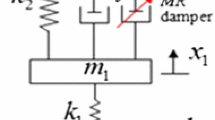Abstract
A semi-active controller-based neural network for a suspension system with magnetorheological (MR) dampers is presented and evaluated. An inverse neural network model (NIMR) is constructed to replicate the inverse dynamics of the MR damper. The typical control strategies are linear quadratic regulator (LQR) and linear quadratic gaussian (LQG) controllers with a clipped optimal control algorithm, while inherent time-delay and non-linear properties of MR damper lie in these strategies. LQR part of LQG controller is also designed to produce the optimal control force. The LQG controller and the NIMR models are linked to control the system. The effectiveness of the NIMR is illustrated and verified using simulated responses of a full-car model. The results demonstrate that by using the NIMR model, the MR damper force can be commanded to follow closely the desirable optimal control force. The results also show that the control system is effective and achieves better performance and less control effort than the optimal in improving the service life of the suspension system and the ride comfort of a car.
Similar content being viewed by others
References
S. H. Zareh, A. Sarrafan, A. A. A. Khayyat and A. Zabihollah, Intelligent semi-active vibration control of eleven degrees of freedom suspension system using magnetorheological dampers, Journal of Mechanical Science and Technology, 26(2) (2012) 323–334.
S. H. Zareh and A. A. A. Khayyat, Fuzzy inverse model of magnetorheological dampers for semi-active vibration control of an eleven-degrees of freedom suspension system, Journal of System Design and Dynamics, 5(7) (2011) 1485–1497.
R. S. Prabakar, C. Sujatha and S. Narayanan, Optimal semiactive preview control response of a half car vehicle model with magnetorheological damper, Journal of sound and vibration, 326 (2009) 400–420.
M. S. Yahaya and H. S. Johari, Modeling and control of the active suspension system using proportional integral sliding mode approach, Asian Journal of Control, 7(2) (2005) 91–98.
S. H. Zareh, A. Sarrafan and A. A. A. Khayyat, Clipped optimal control of 11-DOFs of a passenger car using magnetorheological damper, International Conference on Computer Control and Automation (2011) 162–167.
M. M. M. Salem and A. A. Ayman, Fuzzy control of a quarter-car suspension system, World Academy of Science Engineering and Technology, 53 (2009) 258–263.
H. C. Sohn and K. T. Hong, An adaptive LQG control for semi-active suspension systems, International Journal Vehicle Design, 34(4) (2004) 309–326.
M. Biglarbegian, W. Melek and F. Golnaraghi, Intelligent control of vehicle semi-active suspension system for improved ride comfort and road handling, Fuzzy Information Processing Society (2006) 19–24.
O. Yoshida and S. J. Dyke, Seismic control of a nonlinear benchmark building using smart dampers, Journal of engineering mechanics, 130 (2004) 386–392.
Y. Kim, R. Langari and S. Hurlebaus, Semi-active nonlinear control of a building with a magnetorhelogical damper system, Mechanical Systems and Signal Processing, 23 (2009) 300–315.
M. Ahmadian and C. A. Pare, A quarter car experimental analysis of alternative semi-active control methods, Journal of Intelligent Material Systems and Structures, 11(8) (2000) 604–612.
J. S. Chiou and T. M. Liu, Using fuzzy logic controller and evolutionary genetic algorithm for automotive active suspension system, International Journal of Automotive Technology, 10(6) (2009) 703–710.
J. Sun and Q. Yang, Modeling and intelligent control of vehicle active suspension system, IEEE International conference on RAM (2008) 239–242.
S. Yildirim and I. Eski, Vibration analysis of an experimental suspension system using artificial neural networks, Journal of Scientific & Industrial Research, 68 (2009) 522–529.
V. S. Atray and P. N. Roschke, Neuro-fuzzy control of railcar vibrations using semi active dampers, Computer-Aided Civil and Infrastructure Engineering, 19 (2004) 81–92.
S. H. Sadati, M. A. Shooredeli and A. D. Panah, Designing a neuro-fuzzy controller for a vehicle suspension system using feedback error learning, Journal of mechanics and aerospace, 4(3) (2008) 45–57.
M. T. Hagan and M. B. Menhaj, Training feedforward networks with the Marquardt algorithm, IEEE Trans. on Neural Networks, 5(6) (1994) 989–993.
A. Khajekaramodin and H. Haji-Kazemi, A. Rowhanimanesh and M. R. Akbarzadeh, Semi-active control of structures using neuro-inverse model of MR dampers, Proc. of First Joint Congress on Fuzzy and Intelligent Systems, Mashhad, Iran (2007) 789–803.
A. Sarrafan, S. H. Zareh, A. A. A. Khayyat and A. Zabihollah, Neuro-fuzzy control strategy for an offshore steel jacket platform subjected to wave-induced forces using magnetorheological dampers, Journal of Mechanical Science and Technology, 26(4) (2012) 1–18.
Y. W. Yun, S. M. Lee and M. Park, A study on the efficiency improvement of a passive oil damper using an MR accumulator, Journal of Mechanical Science and Technology, 24(11) (2010) 2297–2305.
Z. D. Xu and Y. Q. Guo, Neuro-fuzzy control strategy for earthquake-excited nonlinear magnetorheological structures, Soil Dynamics and Earthquake Engineering, 28 (2008) 717–727.
Author information
Authors and Affiliations
Corresponding author
Additional information
Recommended by Associate Editor Hyoun Jin Kim
Seiyed Hamid Zareh was born in 1983 and received his B.Sc. degree from the Technical Faculty of Imam Hossein University, Tehran, Iran, in 2006 and his M.Sc. degree from School of Science and Engineering of Sharif University of Technology, Iran, in 2011, all in mechanical and mechatronics engineering. This author became a member of IEEE in 2011. His research interests are mechatronics system, smart materials and structures, automatic control, and intelligent control. He has one book in the field of oil and gas with the title of “Storage Tank Design”, (2005) and one book chapter (2011). He also published four journal and twelve international conference papers. Mr. Zareh is also a member of American Society of Mechanical Engineers (ASME) and Iranian Society of Mechanical Engineers (ISME). He received oral presentation awards at the 2nd, 3rd and 4th symposium in research week in 2009, 2010, 2011 and technical presentation in Singapore 2009, respectively.
Rights and permissions
About this article
Cite this article
Zareh, S.H., Abbasi, M., Mahdavi, H. et al. Semi-active vibration control of an eleven degrees of freedom suspension system using neuro inverse model of magnetorheological dampers. J Mech Sci Technol 26, 2459–2467 (2012). https://doi.org/10.1007/s12206-012-0628-8
Received:
Revised:
Accepted:
Published:
Issue Date:
DOI: https://doi.org/10.1007/s12206-012-0628-8




